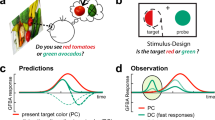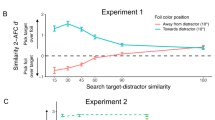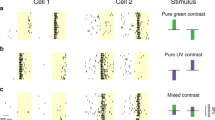Abstract
The brain can process input without perception, but what distinguishes conscious from preconscious processing? Using aftereffects induced by quickly alternating images, we show that cortical mechanisms track color much faster than perception, responding well to color alternations that are too rapid to be perceptible. The more restricted frequency response of the conscious perception of color suggests that extra integrative steps give conscious color perception a time course substantially slower than that of early cortical mechanisms.
This is a preview of subscription content, access via your institution
Access options
Subscribe to this journal
Receive 12 print issues and online access
$209.00 per year
only $17.42 per issue
Buy this article
- Purchase on Springer Link
- Instant access to full article PDF
Prices may be subject to local taxes which are calculated during checkout


Similar content being viewed by others
References
Kelly, D.H. J. Opt. Soc. Am. 73, 742–750 (1983).
Wisowaty, J.J. J. Opt. Soc. Am. 71, 970–977 (1981).
Holcombe, A.O. & Cavanagh, P. Nat. Neurosci. 4, 127–128 (2001).
Gur, M. & Snodderly, D.M. Vision Res. 37, 377–382 (1997).
Williams, P.E., Mechler, F., Gordon, J., Shapley, R. & Hawken, M.J. J. Neurosci. 24, 8278–8288 (2004).
McCollough, C. Science 149, 1115–1116 (1965).
Humphrey, G.K. & Goodale, M.A. Conscious. Cogn. 7, 494–519 (1998).
Hubel, D.H. & Wiesel, T.N. Proc. R. Soc. Lond. B 198, 1–59 (1977).
Solomon, S.G. & Lennie, P. J. Neurosci. 25, 4779–4792 (2005).
Grossberg, S., Hwang, S. & Mingolla, E. Vision Res. 42, 1259–1286 (2002).
He, S., Cavanagh, P. & Intriligator, J. Nature 383, 334–337 (1996).
Shady, S. & MacLeod, D.I.A. Nat. Neurosci. 5, 729–730 (2002).
Shady, S., MacLeod, D.I.A. & Fisher, H.S. Proc. Natl. Acad. Sci. USA 101, 5170–5173 (2004).
He, S. & MacLeod, D.I. Nature 411, 473–476 (2001).
Acknowledgements
We thank E. Shubel for assistance, and J.H. Reynolds, C. Bodelon, L. Huang, C.I. Baker, T. Konkle and M. Williams for comments. This work was supported by grants from the University of California Regents and Sigma Xi to E.V. and by US National Institutes of Health grant EY01711.
Author information
Authors and Affiliations
Corresponding author
Ethics declarations
Competing interests
The authors declare no competing financial interests.
Supplementary information
Rights and permissions
About this article
Cite this article
Vul, E., MacLeod, D. Contingent aftereffects distinguish conscious and preconscious color processing. Nat Neurosci 9, 873–874 (2006). https://doi.org/10.1038/nn1723
Received:
Accepted:
Published:
Issue Date:
DOI: https://doi.org/10.1038/nn1723
This article is cited by
-
Color Afterimages in Autistic Adults
Journal of Autism and Developmental Disorders (2018)
-
Human visual cortex responds to invisible chromatic flicker
Nature Neuroscience (2007)



